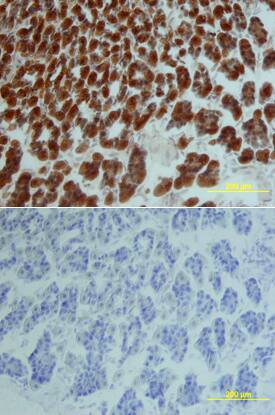Mouse IL-15 Biotinylated Antibody
R&D Systems, part of Bio-Techne | Catalog # BAF447


Key Product Details
Species Reactivity
Validated:
Mouse
Cited:
Mouse
Applications
Validated:
ELISA Detection (Matched Antibody Pair), Immunohistochemistry, Western Blot
Cited:
ELISA Development, Flow Cytometry
Label
Biotin
Antibody Source
Polyclonal Goat IgG
Product Specifications
Immunogen
E. coli-derived recombinant mouse IL-15
Asn49-Ser162
Accession # P48346
Asn49-Ser162
Accession # P48346
Specificity
Detects mouse IL-15 in ELISAs and Western blots. In sandwich immunoassays, less than 0.3% cross-reactivity with recombinant human IL‑15 is observed.
Clonality
Polyclonal
Host
Goat
Isotype
IgG
Scientific Data Images for Mouse IL-15 Biotinylated Antibody
IL‑15 in Mouse Intestine.
IL-15 was detected in perfusion fixed frozen sections of mouse intestine using Mouse IL-15 Biotinylated Antigen Affinity-purified Polyclonal Antibody (Catalog # BAF447) at 15 µg/mL overnight at 4 °C. Tissue was stained using the Anti-Goat HRP-DAB Cell & Tissue Staining Kit (brown; Catalog # CTS008) and counterstained with hematoxylin (blue). Lower panel shows a lack of labeling if primary antibodies are omitted and tissue is stained only with secondary antibody followed by incubation with detection reagents. View our protocol for Chromogenic IHC Staining of Frozen Tissue Sections.IL‑15 in Mouse Intestine.
IL-15 was detected in perfusion fixed frozen sections of mouse intestine using Mouse IL-15 Biotinylated Antigen Affinity-purified Polyclonal Antibody (Catalog # BAF447) at 15 µg/mL overnight at 4 °C. Tissue was stained using the Anti-Goat HRP-DAB Cell & Tissue Staining Kit (brown; Catalog # CTS008) and counterstained with hematoxylin (blue). Lower panel shows a lack of labeling if primary antibodies are omitted and tissue is stained only with secondary antibody followed by incubation with detection reagents. View our protocol for Chromogenic IHC Staining of Frozen Tissue Sections.Applications for Mouse IL-15 Biotinylated Antibody
Application
Recommended Usage
Immunohistochemistry
5-15 µg/mL
Sample: Perfusion fixed frozen sections of mouse intestine
Sample: Perfusion fixed frozen sections of mouse intestine
Western Blot
0.1 µg/mL
Sample: Recombinant Mouse IL-15 (Catalog # 447-ML)
Sample: Recombinant Mouse IL-15 (Catalog # 447-ML)
Mouse IL-15 Sandwich Immunoassay
Please Note: Optimal dilutions of this antibody should be experimentally determined.
Reviewed Applications
Read 1 review rated 5 using BAF447 in the following applications:
Formulation, Preparation, and Storage
Purification
Antigen Affinity-purified
Reconstitution
Reconstitute at 0.2 mg/mL in sterile PBS.
Formulation
Lyophilized from a 0.2 μm filtered solution in PBS with BSA as a carrier protein.
Shipping
The product is shipped at ambient temperature. Upon receipt, store it immediately at the temperature recommended below.
Stability & Storage
Use a manual defrost freezer and avoid repeated freeze-thaw cycles.
- 12 months from date of receipt, -20 to -70 °C as supplied.
- 1 month, 2 to 8 °C under sterile conditions after reconstitution.
- 6 months, -20 to -70 °C under sterile conditions after reconstitution.
Background: IL-15
References
- Grabstein, K. et al. (1994) Science 264:965.
- Budagian, V. et al. (2006) Cytokine Growth Factor Rev. 17:259.
- Ma, A. et al. (2006) Annu. Rev. Immunol. 24:657.
- Tagaya, Y. et al. (1997) Proc. Natl. Acad. Sci. USA 94:14444.
- Giri, J.G. et al. (1995) EMBO J. 14:3654.
- Giri, J. et al. (1994) EMBO J. 13:2822.
- Duitman, E.H. et al. (2008) Mol. Cell. Biol. 28:4851.
- Dubois, S. et al. (2002) Immunity 17:537.
- Stonier, S.W. and K.S. Schluns (2010) Immunol. Lett. 127:85.
- Burkett, P.R. et al. (2004) J. Exp. Med. 200:825.
- Budagian, V. et al. (2004) J. Biol. Chem. 279:40368.
- Mortier, E. et al. (2004) J. Immunol. 173:1681.
- Bulanova, E. et al. (2007) J. Biol. Chem. 282:13167.
- Budagian, V. et al. (2004) J. Biol. Chem. 279:42192.
- Neely, G.G. et al. (2004) J. Immunol. 172:4225.
Long Name
Interleukin 15
Alternate Names
IL15
Entrez Gene IDs
Gene Symbol
IL15
UniProt
Additional IL-15 Products
Product Documents for Mouse IL-15 Biotinylated Antibody
Product Specific Notices for Mouse IL-15 Biotinylated Antibody
For research use only
